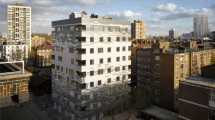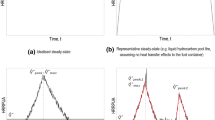Abstract
Physical experiments and computer simulations are commonly employed to characterize and understand fire behaviour under different conditions. Many medium- to large-scale physical experiments utilize standardized wood cribs as the fire load, while corresponding computer simulations require physical and combustion properties of such fire loads. The design of physical experiments and accuracy of computational models depend heavily on the underlying combustion models. The current study proposes an improved two-step combustion model for soft and hard wood based on physical characterization of different wood samples. Two different types of wood, i.e. softwood and hardwood were characterized using cone calorimeter. Total of six cone tests were performed under irradiation levels of 30, 50 and 75 kW m−2 for each wood sample. Thermogravimetry analysis (TGA) of wood samples was carried out to estimate the combustion kinetic parameters (through different estimation methods) like activation energy, pre-exponential factor, and reaction order for numerical simulation of cone calorimeter tests. The kinetic parameters estimated through the Kissinger–Akahira–Sunose integral method were utilized to perform computer simulation of TGA and cone calorimeter in fire dynamic simulator (FDS) using one-step and two-step combustion models. Thermal degradation temperatures of both the types of wood were observed to be between of 200 and 500 ℃. During whole pyrolysis process, softwood was observed to possess larger activation energy than that of hardwood. The reaction models for softwood and hardwood were found to be diffusion type with reaction order of 2–3. TGA simulation results obtained by the two-step simulation approach were found to be better than that of one-step simulation approach. In case of cone calorimeter simulations, the two-step simulation approach yielded better prediction of heat release rate and time to ignition as compared to that of the one-step simulation approach. It is expected that the present study would be helpful in large-scale FDS fire simulation involving softwood and hardwood.











Similar content being viewed by others
References
Moinuddin K, Razzaque QS, Thomas A. Numerical simulation of coupled pyrolysis and combustion reactions with directly measured fire properties. Polymers. 2020;12(9):2075. https://doi.org/10.3390/polym12092075.
Xu Q, Chen L, Harries KA, Zhang F, Liu Q, Feng J. Combustion and charring properties of five common constructional wood species from cone calorimeter tests. Constr Build Mater. 2015;96:416–27.
Martinka J, Mozer V, Hroncová E, Ladomerský J. Influence of spruce wood form on ignition activation energy. Wood Res. 2015;60(5):815–22.
Bartlett AI, Hadden RM, Bisby LA. A review of factors affecting the burning behaviour of wood for application to tall timber construction. Fire Technol. 2019;55:1–49.
Amaral SS, De Carvalho Junior JA, Costa M, Neto TG, Dellani R, Leite L. Comparative study for hardwood and softwood forest biomass: chemical characterization, combustion phases and gas and particulate matter emissions. Bioresour Technolol. 2014;164:55–63.
Gronli MG, Antal MJ, Varhegyi GA. Round-robin study of cellulose pyrolysis kinetics by thermogravimetry. Ind Eng Chem Res. 1999;38(6):2238–44.
Yang H, Yan R, Chen H, Lee DH, Zheng C. Characteristics of hemicellulose, cellulose and lignin pyrolysis. Fuel. 2007;86:1781–8.
Gasparovic L, Korenova Z, Jelemensky L. Kinetic study of wood chips decomposition by TGA. Chem Pap. 2010;64(2):174–81.
Garcia-Perez M, Chaala A, Pakdel H, Kretschmer D, Roy C. Vacuum pyrolysis of softwood and hardwood biomass: comparison between product yields and bio-oil properties. J Anal Appl Pyrol. 2007;78:104–16.
Wang S, Ru B, Lin H, Sun W. Pyrolysis behaviors of four O-acetyl-preserved hemicelluloses isolated from hardwoods and softwoods. Fuel. 2015;150:243–51.
Liu Q, Wang S, Zheng Y, Luo Z, Cen K. Mechanism study of wood lignin pyrolysis by using TG–FTIR analysis. J Anal Appl Pyrol. 2008;82:170–7.
Yao F, Wu Q, Lei Y, Guo W, Xu Y. Thermal decomposition kinetics of natural fibers: activation energy with dynamic thermogravimetric analysis. Polym Degrad Stab. 2008;93:90–8.
Ding Y, Ezekoye OA, Lu S, Wang C, Zhou R. Comparative pyrolysis behaviors and reaction mechanisms of hardwood and softwood. Energy Convers Manag. 2017;132:102–9.
Babrauskas V. Development of the cone calorimeter-A bench-scale heat release rate apparatus based on oxygen consumption. Fire Mater. 1984;8(2):81–95.
Abu-Bakar SA, Cran M, Wadhwani R, Khalid A. Characterisation of pyrolysis and combustion parameters of charring materials most frequently found in buildings. J Therm Anal Calorim. 2020;139:2985–99.
Dietenberger MA, Grexa O, White RH. Reaction-to-fire of wood products and other building materials: Part II. Cone Calorimeter Tests and Fire Growth Models; US Department of Agriculture, Forest Service, Forest Products Laboratory, 2012; No. FPL-RP-663.
Schartel B, Hull TR. Development of fire-retarded materials—Interpretation of cone calorimeter data. Fire Mater. 2007;31:327–54.
Shahfizadeh F, Chin PPS. Thermal deterioration of wood. ACS Symposium Ser. 43, American Chemical Society 1977: 57–81.
Atreya A. Fire growth on horizontal surfaces of wood. Ph.D. Thesis, Harvard University. 1983.
Blasi CD. Modeling chemical and physical processes of wood and biomass pyrolysis. Prog Energy Combust Sci. 2008;34(1):47–90.
Opfermann JR, Kaisersberger E, Flammersheim HJ. Model-free analysis of thermoanalytical data advantages and limitations. Thermochim Acta. 2002;391:119–27.
Friedman HL. Kinetics of thermal degradation of char-forming plastics from thermogravimetry: application to a phenolic plastic. J Polym Sci Part-C 1964;6(1):183–195
Arshad MA, Maaroufi A, Benavente R, Perena JM, Pinto G. Thermal degradation kinetics of insulating/conducting epoxy/zn composites under nonisothermal conditions. Polym Compos. 2013;34(12):2049–60.
Venkatesh M, Ravi P, Tewari SP. Isoconversional kinetic analysis of decomposition of nitroimidazoles: Friedman method vs Flynn–Wall–Ozawa method. J Phys Chem A. 2013;117:10162–9.
Flynn JH, Wall LA. General treatment of the thermogravimetry of polymers. J Res Natl Bureau Stand-A Phys Chem. 1966;70A(6):487–523.
Ozawa T. A new method of analyzing thermogravimetric data. Bull Chem Soc Jpn. 1965;38:1881–7.
Ozawa T. Thermal analysis-review and prospect. Thermochim Acta. 2000;355:35–42.
Kissinger HE. Reaction kinetics in differential thermal analysis. Anal Chem. 1957;29(11):1702–6.
Coats AW, Redfern JP. Kinetic parameters from thermogravimetric data II. Polym Lett. 1965;3:917–20.
Constable FH. The mechanism of catalytic decomposition. J Chem Soc. 1925;123:355–77.
Vyazovkin S, Burnham AK, Criado JM, Pérez-Maqueda LA, Popescud C, Sbirrazzuolie N. ICTAC kinetics committee recommendations for performing kinetic computations on thermal analysis data. Thermochim Acta. 2011;520:1–19.
Hostikka S, Matala A. Pyrolysis model for predicting the heat release rate of birch wood. Combust Sci Technol. 2017;189(8):1373–93.
Yuen ACY, Chen TBY, Yeoh GH, Yang W, Cheung SCP, Cook M, Yu B, Chan QN, Yip HL. Establishing pyrolysis kinetics for the modelling of the flammability and burning characteristics of solid combustible materials. J Fire Sci. 2018;36(6):494–517.
Dong CQ, Zhang ZF, Lu Q, Yang YP. Characteristics and mechanism study of analytical fast pyrolysis of poplar wood. Energy Convers Manag. 2012;57:49–59.
Maa Z, Chen D, Gu J, Bao B, Zhang Q. Determination of pyrolysis characteristics and kinetics of palm kernel shell using TGA–FTIR and model-free integral methods. Energy Convers Manag. 2015;89:251–9.
Hagge MJ, Bryden KM, Dietenberger MA. Effects of backing board materials on wood combustion performance. Wood & fire safety: proceedings, 5th international scientific conference, April 18–22 2004, Faculty of Wood Sciences and Technology, pp. 51–58.
Brown JE, Braun E, Twilley WH. Cone Calorimeter Evaluation of the Flammability of Composite Materials. US Department of Commerce, Center for Fire Research, March 1988.
Zhang S, Ni X, Zhao M, Feng J, Zhang R. Numerical simulation of wood crib fire behavior in a confined space using cone calorimeter data. J Therm Anal Calorim. 2015;119:2291–303.
Cachim PB, Franssen JM. Assessment of Eurocode 5 charring rate calculation methods. Fire Technol. 2010;46:169–81.
Sarvaranta L, Kokkala M. Smoke production in fires. Espoo 1995, Technical Research Centre of Finland, VTT Tiedotteita - Meddelanden - Research Notes 1708; 32 p.
Zhang J, Guo Y, Chen Q, Luo C. Kinetic analysis, solid residues and volatile products of pyrolyzing nomex insulation paper in nitrogen and air atmosphere. Fire Technol. 2022. https://doi.org/10.1007/s10694-022-01266-7.
Gronli MG, Varhegyi G, Blasi CD. Thermogravimetric analysis and devolatilization kinetics of wood. Ind Eng Chem Res. 2002;41:4201–8.
Yu J, Paterson N, Blamey J, Millan M. Cellulose, xylan and lignin interactions during pyrolysis of lignocellulosic biomass. Fuel. 2017;191:140–9.
Ding Y, Ezekoye OA, Lu S, Wang C. Thermal degradation of beech wood with thermogravimetry/Fourier transform infrared analysis. Energy Convers Manag. 2016;120:370–7.
Wild PJ, Uil HD, Johannes HR, Lunshof A, Hendriks C, Ernst RHE, Erik JH. Bioenergy II: biomass valorisation by a hybrid thermochemical fractionation approach. Int J Chem React Eng. 2009;A51(7):1–27.
Khawam A, Flanagan DR. Solid-state kinetic models: basics and mathematical fundamentals. J Phys Chem B. 2006;110:17315–28.
Li KY, Huang X, Fleischmann C, Rein G, Ji J. Pyrolysis of medium-density fiberboard: optimized search for kinetics scheme and parameters via a genetic algorithm driven by Kissinger’s method. Energy Fuels. 2014;28(9):6130–9.
Ding Y, Wang C, Chaos M, Chen R, Lu S. Estimation of beech pyrolysis kinetic parameters by shuffled complex evolution. Biores Technol. 2016;200:658–65.
Jancík J, Magdolenová P, Markert F. Comparison of cone calorimetry and FDS model of low-density fiberboard pyrolysis. In: Makovicka Osvaldova L, Markert F, Zelinka S, editors. Wood & fire safety. WFS 2020. Cham: Springer; 2020. https://doi.org/10.1007/978-3-030-41235-7_22.
Ding Y, Fukumoto K, Ezekoye OA, Lu S, Wang C, Li C. Experimental and numerical simulation of multi-component combustion of typical charring material. Combust Flame. 2020;211:417–29.
Jankovic B, Jankovic MM. Pyrolysis of pine and beech wood under isothermal conditions: the conventional kinetic approach. Res Chem Intermed. 2015;41(4):2201–19.
Acknowledgements
The authors gratefully acknowledge the Centre for Safety Engineering at IIT Gandhinagar for support of this work. Support through Dr. Vilas Mujumdar Chair fellowship is also acknowledged.
Author information
Authors and Affiliations
Contributions
DN carried out the experiments and related analysis. He also created the first draft of the manuscript. MKT carried out review of experimental and simulation results and helped in editing the drafts leading to the final version. TW carried out computer simulations and related analysis. GS conceptualized the overall study, methods and analyses. He also reviewed the manuscript drafts and finalized the manuscript being submitted. All authors read and approved the final manuscript.
Corresponding author
Additional information
Publisher's Note
Springer Nature remains neutral with regard to jurisdictional claims in published maps and institutional affiliations.
Appendix 1
Appendix 1
Rights and permissions
Springer Nature or its licensor (e.g. a society or other partner) holds exclusive rights to this article under a publishing agreement with the author(s) or other rightsholder(s); author self-archiving of the accepted manuscript version of this article is solely governed by the terms of such publishing agreement and applicable law.
About this article
Cite this article
Nakrani, D., Tiwari, M.K., Wani, T. et al. Characterization of combustion of hardwood and softwood through experimental and computer simulations. J Therm Anal Calorim 148, 7727–7745 (2023). https://doi.org/10.1007/s10973-023-12261-7
Received:
Accepted:
Published:
Issue Date:
DOI: https://doi.org/10.1007/s10973-023-12261-7




